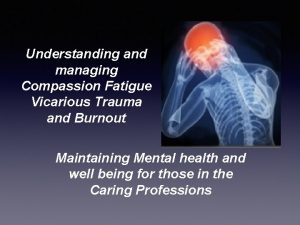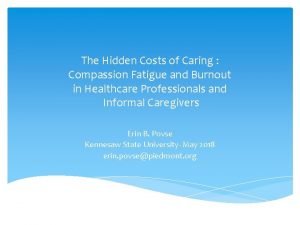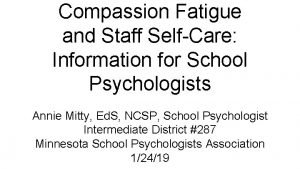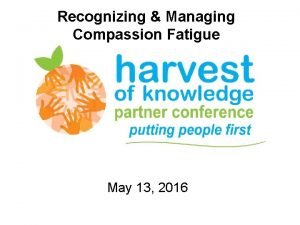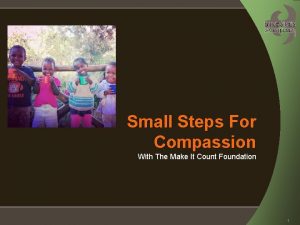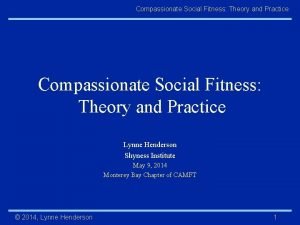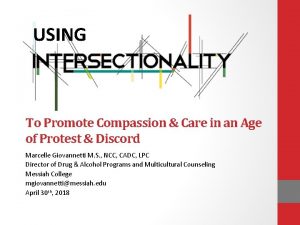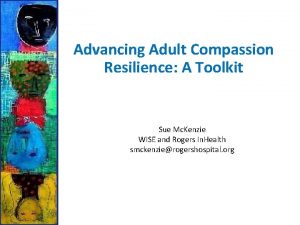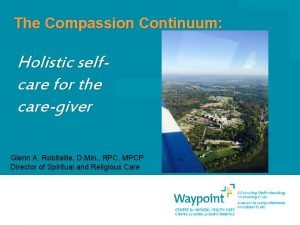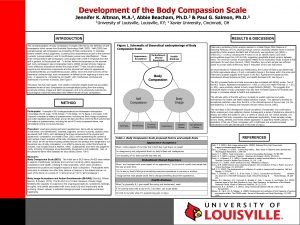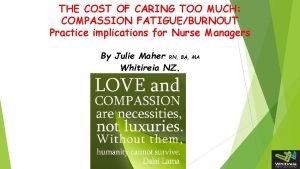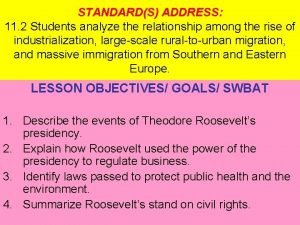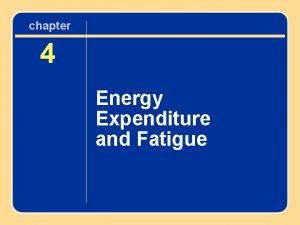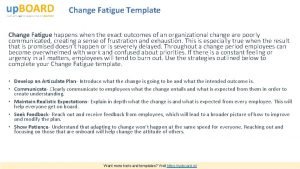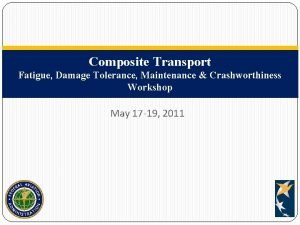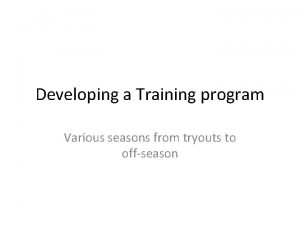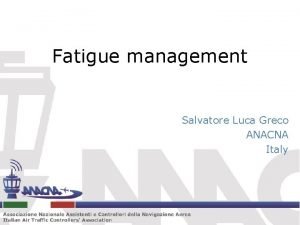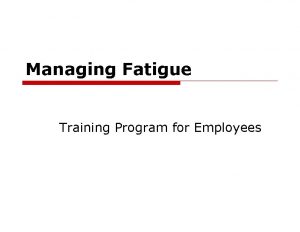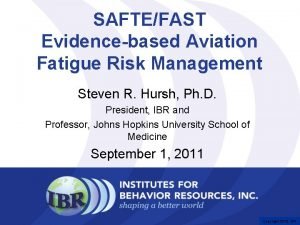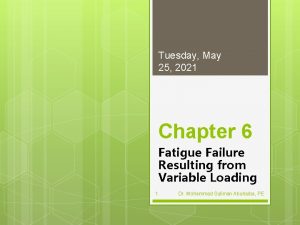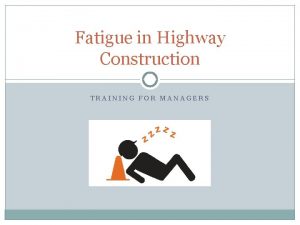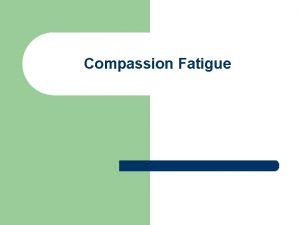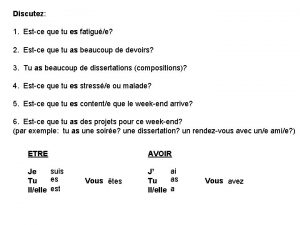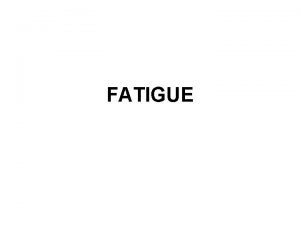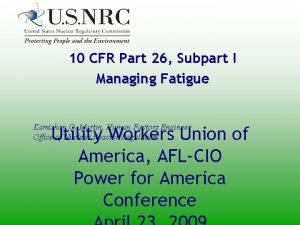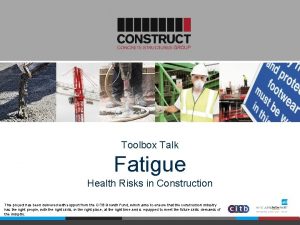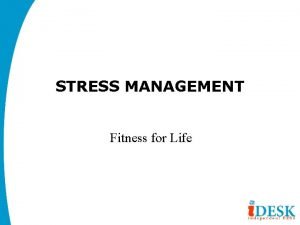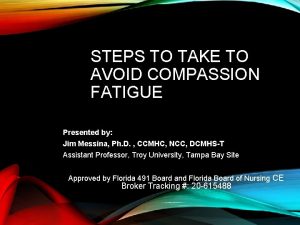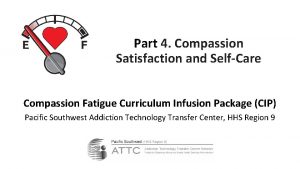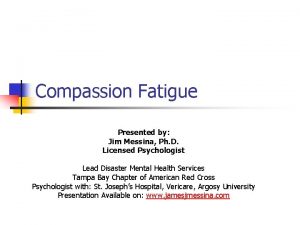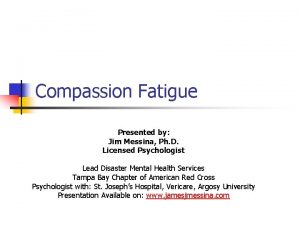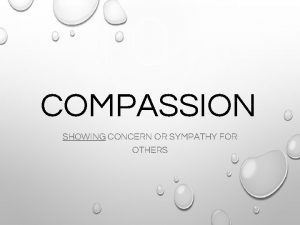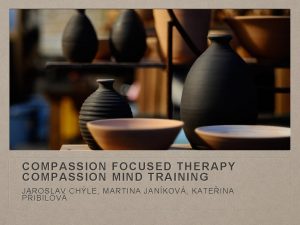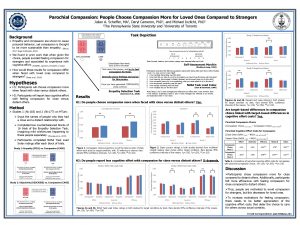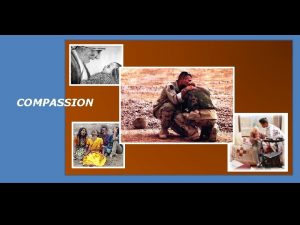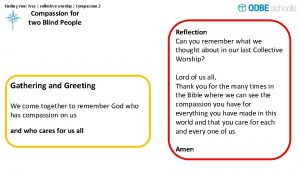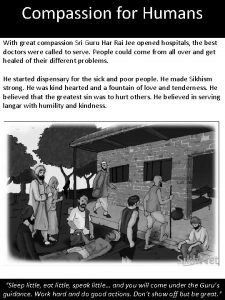STEPS TO TAKE TO AVOID COMPASSION FATIGUE Presented











































































- Slides: 75

STEPS TO TAKE TO AVOID COMPASSION FATIGUE Presented by: Jim Messina, Ph. D. , CCMHC, NCC, DCMHS-T Assistant Professor, Troy University, Tampa Bay Site Approved by Florida 491 Board and Florida Board of Nursing CE Broker Tracking #: 20 -615488

Description of Program: Professional Helpers are prone to Compassion Fatigue or Burnout on the job. Compassion fatigue is thought to be a combination of secondary traumatization and burnout precipitated by the care delivery that brings professional helpers into contact with the suffering of their helpees. Compassion fatigue is when helpers have such deep empathy they develop symptoms of trauma like their helpees. Compassion Fatigue can also resemble burnout which occurs when emotional exhaustion is experienced due to increased workload and institutional stress and does not involve trauma. Compassion Fatigue can have detrimental effects on clinical relationships since helpers suffering from it often either grow distant from their helpees or get too close to them. Professional Helpers need to learn how to improve their selfcare, handle the stressors involved in their work by self-care activities such as Mindfulness Meditation, Yoga, Exercise, Good Diet, Healthy Sleep. Etc. Learning Objectives 1. To learn how to identify if helpers are having problems maintaining a healthy focus with their helpees. 2, To learn how to identify if helpers are a compulsive fixers or rescuers which could impact their maintaining healthy working relationships with their helpees. 3. To learn how to assist helpers if they are suffering from Compassion Fatigue which could impact their maintaining healthy working relationships with their helpees. 4, To identify tips on how helpers can maintain healthy working relationships with their helpees while maintaining their own emotional and physical health.

"The pessimist complains about the wind; The optimist expects it to change; The realist adjusts the sails. " William Arthur Ward

GOALS FOR OUR PROGRAM 1. Identify Compassion Fatigue through Self-Assessment & Remediation Plan for Health care professionals 2. Identify Physical exercises, aerobic & mobility activities that improve self-care for Health care professionals 3. Identify a Nutritional regimen that sustains health, energy & cognitive clarity of health care professionals 4. Identify how competency based continuing education improves the self-care of Health care professionals 5. Identify how to maintain one’s sense of humor & emotional balance as a Health care professional 6. Identify what you are willing to commit to which will improve your self-care from this point on

WHAT MIGHT BE SETTING YOU UP FOR COMPASSION FATIGUE? ØAre you an addicted fixer or rescuer? Maybe this is keeping you from maintaining healthy emotional detachment with your clients ØTake self-assessment instrument entitled: Compulsive Fixer-Rescuer Self-Assessment

SO ARE YOU A COMPULSIVE FIXER OR RESCUER? Results: if on this survey you have answered: Ø 3 or more items with scores of 7 or higher or Ø 5 or more items with scores of 5 or higher Ø There is a strong possibility that you are maintaining weak emotional detachment with your clients and/or their families because of your being an “addicted fixer” or “rescuer” which result in compassion fatigue

WHO IS SUSCEPTIBLE TO COMPASSION FATIGUE? Helpers who are most susceptible to this condition work with people who fit one or more of the following categories: 1. Survivors of Domestic Violence, Physical & Sexual Abuse, Torture, Trauma, or Natural or Man-made Disasters 2. Individuals suffering from PTSD from being in Wars or other prior war or other traumatic life events 3. People who have sustained permanent physical and or emotional Injuries after surviving traumatic events 4. Patients dealing with life threatening illness like cancer, heart & lung conditions, HIV-AIDS, or other systemic health conditions 5. Hospice eligible individuals facing imminent death due to old age, injury, disease or illnesses

WHAT IS COMPASSION FATIGUE? Compassion fatigue is thought to be a combination of secondary traumatization & burnout precipitated by the care delivery that brings health-care professionals into contact with the suffering Szabo, B. (2006). Compassion fatigue and nursing work: Can we accurately capture the consequences of caring work? International Journal of Nursing Practice: 12: 136– 142.

DIFFERENCE BETWEEN COMPASSION FATIGUE & BURNOUT • "Compassion fatigue is when caregivers have such deep empathy they develop symptoms of trauma similar to the patient” according to director of the Army Institute of Surgical Research Col Kathryn Gaylord • The disorder can also resemble burn out which occurs when emotional exhaustion is experienced due to increased workload & institutional stress & does not involve trauma • Compassion fatigue can have detrimental effects on doctor patient relationships since doctors suffering from the disorder often either grow distant from patients or get too close Wilson, E. (2008). New Program Offers Care for Caregivers. Department of Defense Military Health System News, 23 May 2008.

SECONDARY TRAUMATIC STRESS • People who come into continued, close contact with trauma survivors may also experience emotional disruption, becoming indirect victims of the trauma • The natural, consequent behaviors & emotions resulting from knowledge about a traumatizing event experienced by a significant other • The stress resulting from helping or wanting to help a traumatized or suffering person Bride, B. (2007). Prevalence of Secondary Traumatic Stress Among Social Workers. Social Work: 51(2): 63 -70.

COMPASSION SATISFACTION • Compassion satisfaction is the ability for helpers to derive a great sense of meaning & purpose from their work • It may aid in alleviating existential terror endemic to the human condition when a society is at war • It may be an important buffer in managing & transcending alterations in belief systems & physiological or emotional reactions seen in compassion fatigue Stamm (1999 and 2002) as quoted in: Tyson, J. (2007). Compassion Fatigue in the Treatment of Combat-Related Trauma During Wartime. Clinical Social Work Journal; 35: 183– 192

MAJOR FACTORS CONTRIBUTING TO COMPASSION FATIGUE 1. 2. 3. 4. Poor self-care Previous unresolved trauma Inability or refusal to control work stressors Lack of satisfaction for the work Figley, C. R. (Ed. ) (1995). Compassion fatigue: Coping with secondary traumatic stress disorder in those who treat the traumatized. New York: Brunner/Mazel.

PREDICTORS OF COMPASSION FATIGUE AMONG HOSPICE NURSES 1. 2. 3. 4. Trauma Anxiety Life demands Excessive empathy (leading to blurred professional boundaries) Abendroth, M. & Flannery, J. (2006). Predicting the Risk of Compassion Fatigue: A Study of Hospice Nurses. Journal of Hospice and Palliative Nursing: 8(6): 346 -356.

WHY FOCUS ON COMPASSION FATIGUE? • It is imperative that healthcare helpers take steps to ensure that they are functioning at their best in therapeutic relationship • Facilitating their own personal well–being & avoiding burnout is clearly one way in which this can be achieved Linley, P. A. & Joseph, S. (2007). Therapy work and therapists’ positive and negative well-being. Journal of Social and Clinical Psychology: 26(3): 385– 403.

SELF-ASSESSMENT • Take the Compassion Self-Assessment • Rate each item on a scale from 1 to 10 • 1 = never experienced • 5 = occasionally experienced • 10 = frequently experienced

WHAT DOES THIS ASSESSMENT TELL YOU? • If you rated three or more items over 8 or if you rated 5 -10 over 5 • You are most likely experiencing some level of compassion fatigue already

CHARACTERISTICS OF HELPERS EXPERIENCING COMPASSION FATIGUE Physically: Chronic sense of exhaustion & fatigue, insomnia, headaches, stomachaches, lack of appetite, physical agitation or retardation, frequent bouts of sickness (e. g. , colds, sore throats) Psychologically: often feel irritable, are overwhelmed by the volume & content of their work Relationship with Clients: sense a reduction in their baseline empathy for others, feel numb to patients’ & families’ pain, are cynical regarding clients’ ability to change &/or perceive them as being responsible for many of their problems Organizationally: often report a sense of feeling scattered & unable to meet their professional & personal obligations Mendenhall, T. (2006). Trauma-Response Teams: Inherent Challenges and Practical Strategies in Interdisciplinary Fieldwork. Families Systems, & Health: 24(3): 357 -362.

WHAT LEVEL OF STRESS ARE YOU DEALING WITH IN YOUR LIFE? Personal life events analysis: To learn the level of stress (distress) in your life, mark down on the PERSONAL LIFE EVENTS ANALYSIS the value at the right of each of the life events if it has occurred within the past 12 -24 months for you. Then tally up the all the values you put in the blanks before the Events true for you

PERSONAL LIFE EVENTS ANALYSIS SCORES This scale shows the kind of life pressure that you are facing. Depending on your coping skills or the lack thereof, this scale can predict the likelihood that you will fall victim to a stress related illness. The illness could be mild - frequent tension headaches, acid indigestion, loss of sleep to very serious illness like ulcers, cancer, migraines and the like. 0 -149: Low susceptibility to stress-related illness 150 -299: Medium susceptibility to stress-related illness: Learn and practice relaxation and stress management skills and a healthy well life style. 300 and over: High susceptibility to stress-related illness: Daily practice of relaxation skills is very important for your wellness. Take care of it now before a serious illness erupts or an affliction becomes worse. SOURCE: http: //www. coping. us/toolsforpersonalgrowth/stressreduction. html

SUGGESTED USES FOR PERSONAL LIFE-EVENTS ANALYSIS • Become familiar with the different events and the amounts of stress they promote. • Put the list of events where your family can easily refer to it several times a day. • Practice recognizing the stress level when one of these events happens. • Think about the meaning of the event for you and identify your feelings. • Think about the different ways you can adjust to the event. • Take your time in arriving at decisions. • Anticipate life changes and plan for them well in advance whenever possible. • Pace yourself. It can be done even if you are in a hurry. • Look at the accomplishment of a task as a part of ongoing daily living; avoid looking at such an achievement as a stopping point. Congratulate yourself and push ahead. • Recognize that your internal mechanism of coping with stress is directly tied to how your health and well-being will be influenced by it.


RESULTS OF EMPATH TEST SCORE OF 0 - 25: You have some Empath traits, but wouldn't be considered a true Empath. It's important to make sure that you still take care of yourself and don't let yourself get overwhelmed, but it's likely you are pretty balanced between helping others and setting good boundaries. SCORE OF 25 - 50: This score on the Empath Test shows that you are definitely an Empath. You sense things in a way that's different from the average person. You aren't just relating to someone's feelings, you are sensing them as your own. You likely get exhausted sometimes and wonder why, without realizing you are giving out too much positive energy and taking in too much negative energy from around you. While you are fairly balanced if you are in this range, there's no doubt you'd benefit from tools and resources to help you to use your EFP (extra-feeling perception) to be a benefit to yourself and the world. SCORE OF 50 – 75: You are an "extreme Empath. ". You have the ability to soak in others' emotions without consciously knowing you are doing so. You sense the "vibe" of a room or place without visual clues (such as tears, yelling, or slamming of doors). More importantly, if you are scoring this high on the Empath Test, then you are extremely open to the pain and suffering of the world, and you likely get overwhelmed by trying to do too much or help too many people at once. If you don't get some tools and resources to help you, these extreme Empath traits can cause you to get very sick (chronic fatigue is extremely common among Empaths who score like this and don't have the tools to take care of themselves). SOURCE: http: //www. tarameyerrobson. com/empath-test/

PROFESSIONAL QUALITY OF LIFE SCALE (PROQOL) We now want to use the PROQOL: When you help people you have direct contact with their lives. As you may have found, your compassion for those you help can affect you in positive and negative ways. On the PROQOL are some questions about your experiences, both positive and negative, as a helper. Consider each of the questions about you and your current work situation. Select the number that honestly reflects how frequently you experienced these things in the last 30 days.

EXPLANATION OF THE THREE VARIABLE MEASURED ON THE PROQOL 1. Compassion Satisfaction Compassion satisfaction is about the pleasure helpers derive from being able to do their work well. For example, they may feel like it is a pleasure to help others through their work. They may feel positively about their colleagues or their ability to contribute to the work setting or even the greater good of society. Higher scores on this scale represent a greater satisfaction related to their ability to be an effective caregiver in their job. The average score is 50 (SD 10; alpha scale reliability. 88). About 25% of people score higher than 57 and about 25% of people score below 43. If you are in the higher range, you probably derive a good deal of professional satisfaction from your position. If your scores are below 40, you may either find problems with your job, or there may be some other reason—for example, you might derive your satisfaction from activities other than your job.

2. Burnout Most people have an intuitive idea of what burnout is. From the research perspective, burnout is one of the elements of Compassion Fatigue (CF). It is associated with feelings of hopelessness and difficulties in dealing with work or in doing your job effectively. These negative feelings usually have a gradual onset. They can reflect the feeling that your efforts make no difference, or they can be associated with a very high workload or a nonsupportive work environment. Higher scores on this scale mean that you are at higher risk for burnout. The average score on the burnout scale is 50 (SD 10; alpha scale reliability. 75). About 25% of people score above 57 and about 25% of people score below 43. If your score is below 43, this probably reflects positive feelings about your ability to be effective in your work. If you score above 57 you may wish to think about what at work makes you feel like you are not effective in your position. Your score may reflect your mood; perhaps you were having a “bad day” or are in need of some time off. If the high score persists or if it is reflective of other worries, it may be a cause for concern.

3. Secondary Traumatic Stress The second component of Compassion Fatigue (CF) is secondary traumatic stress (STS). It is about Helpers' work related, secondary exposure to extremely or traumatically stressful events. Developing problems due to exposure to other’s trauma is somewhat rare but does happen to many people who care for those who have experienced extremely or traumatically stressful events. For example, Helpers may repeatedly hear stories about the traumatic things that happen to other people, commonly called Vicarious Traumatization. If their work puts them directly in the path of danger, for example, field work in a war or area of civil violence, this is not secondary exposure; their exposure is primary. However, if they are exposed to others’ traumatic events as a result of their work, for example, as a therapist or an emergency worker, this is secondary exposure. The symptoms of STS are usually rapid in onset and associated with a particular event. They may include being afraid, having difficulty sleeping, having images of the upsetting event pop into mind, or avoiding things that remind them of the event.

Secondary Traumatic Stress (continued) The average score on this scale is 50 (SD 10; alpha scale reliability. 81). About 25% of people score below 43 and about 25% of people score above 57. If your score is above 57, you may want to take some time to think about what at work may be frightening to you or if there is some other reason for the elevated score. While higher scores do not mean that you do have a problem, they are an indication that you may want to examine how you feel about your work and your work environment. You may wish to discuss this with your supervisor, a colleague, or a health care professional. B. Hudnall Stamm, 2009 -2012. Professional Quality of Life: Compassion Satisfaction and Fatigue Version 5 (Pro. QOL). www. proqol. org. .

SO WHY ASSESS FOR CHRONIC FATIGUE • It is expected that most helpers will at times experience symptoms of compassion fatigue, as these are normal reactions to trauma work • However, for some helpers the experience of compassion fatigue may become so severe as to interfere with their clinical effectiveness & their personal mental health • It is for this reason that ongoing monitoring is necessary Bride, B. , Radey, M. & Figley, C. R. (2007). Measuring Compassion Fatigue. Clinical Social Work Journal: 35: 155 -163.

EARLY ASSESSMENT IMPACT • Instead of waiting for the helpers to become symptomatic use inventory tools to look for the presence of challenges to their fundamental assumptions, values & beliefs • With early assessment helpers have the opportunity to transform their discomfort into personal growth & development • This should be the aim of a professional supervision & support model to address Compassion Fatigue Tehrani, N. (2007). The cost of caring – the impact of secondary trauma on assumptions, values and beliefs. Counselling Psychology Quarterly: 20(4): 325– 339.

WHAT YOU CAN DO! • • Recognize the symptoms of compassion fatigue Learn to ask for help Be aware & accept the limitations of your family, your job & yourself Maintain discipline in daily responsibilities & duties Take “time out” during the day Take short vacations at least twice a year Try to change little things that gnaw at you & accommodate to those you can't change • Organize your time so you can concentrate on vital tasks • Admit compassion fatigue is a real problem for you & don't try to cover it up • Distinguish between stressful aspects of your job or home life that you can change & those you can't change-change what you can

WHAT YOU CAN DO TO WARD OFF COMPASSION FATIGUE 1. 2. 3. 4. Boundary maintenance Self-care Good training Good supervision If given all 4, Healthcare Helpers will thrive as compassionate professionals Radey, M. & Figley, C. R. (2007). The Social Psychology of Compassion. Clinical Social Work: 35(1): 207– 214

WHAT CAN BE DONE ON THE JOB! • Identify realistic attainable goals for yourself & evaluate accordingly • Work at maintaining personal growth both at home & on the job • Develop an active outside life with a variety of interests • Personalize your work environment with meaningful pictures, objects, colors, etc. • Be comfortable with yourself by setting limits as to how far you will become involved with clients & colleagues

• Practice good communication skills on the job • Arrange for flexible working conditions on the job • Try new ideas “outside of the box” • Use “decompression techniques” activities such as meditation or exercise that relieve tension & put yourself into a more relaxed state • Build support systems among fellow staff membersto discuss problems & help each other look for solutions. Don't just air gripes - look for solutions

IMPLEMENT STRESS REDUCTION & RELAXATION BREAKS Remember what Yogi Berra said about the game: “ 90% of the game is half mental” So learn to put the mental half aside and relax and let go of the stressors from the work you do on a daily basis

OK? NOW LET’S TALK SLEEP! • We all know that adults need 8 hours of sound restful sleep every night • This is especially true for Healthcare Helpers who work with clients who have loads of stress & trauma in their lives • SO what are you going to do about it?

SO REMEMBER YOU NEED TO HAVE ALL 8 HOURS After all Yogi said in this regard: “A nickel ain’t worth a dime anymore” So don’t kid yourself anything less than 8 hours will not do!!!

TRAINING LIKE THIS HELPS!!! Specialized trauma training does enhance Compassion Satisfaction and reduces levels of Compassion Fatigue and Burnout Knowledge & training might provide some protection against the deleterious effects of trauma exposure Sprang, G. , Clark, J. & Whitt-Woosley, A. (2007). Compassion Fatigue, Compassion Satisfaction, and Burnout: Factors Impacting A Professional’s Quality of Life. Journal of Law and Trauma, 12: 259– 280.

CAUSE YOU NEED TO REMEMBER Yogi said: “If the world was perfect, it wouldn’t be” So continue to gain training on Trauma and its impact on clients & helpers so as to learn how to improve the world in which you work

SO GET MORE TRAINING ON PREVENTION OF COMPASSION FATIGUE It helps to refresh everyone’s understanding of the impact of the Trauma, which patients & clients have experienced, on the Healthcare Helpers who are working with these victims & survivors of trauma

TOP 10 SELF-CARE TIPS FOR HELPERS 1. Take Stock-What you are doing Make a list of all the demands on your time & energy (Work, Family, Home, Health, Volunteering, other). Try to make this list as detailed as you can. Eg: Under the Work category, list the main stressors you see (number of clients, or, amount of paperwork, or difficult boss, etc). Once you have the list, take a look at it. What stands out? What factors are contributing to making your stressed out? What life situations or things you have taken on or happened to you? What would you like to change most? Reference: Mathieu, Francois (2007). www. compassionfatigue. ca

TOP 10 SELF-CARE TIPS FOR HELPERS 2. Start a Self-Care Idea Collection Brainstorm a list of self-care behaviors with friends and coworkers. Once you have your list, pick three ideas that jump out at you. Make a commitment to implement these in your life within the next month. Ask a friend/colleague if they would commit to supporting you (and you them) in maintaining your self care goals. This could mean that they go to the gym with you every Thursday, or that they email you at lunch to remind you to get out of your office. This is a way to stay on track and to validate your own experiences by sharing them.

TOP 10 SELF-CARE TIPS FOR HELPERS 3. Find time for yourself every day – Rebalance your workload Do you work straight through lunch? Do you spend weekends running errands and catching up on your week without ever having 20 minutes to sit on the couch and do nothing? Can you think of simple ways to take mini breaks during a work day? What would work for you? Not everyone has control over their caseload, but many do, providing they see all the clients that need to be seen. Would there be a way for you to adjust your load so that you don’t see the most challenging clients all in a row? Make sure you do one nourishing activity each day. This could be having a 30 minute bath with no one bothering you, going out to a movie, or it could simply mean taking 10 minutes during a quiet time to sit and relax. Even small changes can make a difference in a busy helper’s life.

TOP 10 SELF-CARE TIPS FOR HELPERS 4. Delegate - learn to ask for help at home and at work Are there things that you are willing to let go of and let others do their own way? Don’t expect others to read your mind: consider holding a regular family meeting to review the workload and discuss new options. Think of this: If you became ill and were in hospital for the next two weeks, who would look after things on the home front? The same goes for work. Talk with your supervisor and co-workers about the workload that you all carry and see if you as a team can come up new paradigm shifting models to take excessive pressure off of yourself and your fellow colleagues.

TOP 10 SELF-CARE TIPS FOR HELPERS 5. Have a transition from work to home Do you have a transition time between work and home? Do you have a 20 minute walk home through a beautiful park or are you stuck in traffic for two hours? Do you walk in the door to kids fighting and hanging from the curtains or do you walk into a peaceful house? Do you have a transition process when you get home? Do you change clothes? Helpers have found that their best strategies involved a transition ritual of some kind: putting on cozy clothes when getting home and mindfully putting their work clothes “away” as in putting the day away as well, having a 10 minute quiet period to shift gears, going for a run. Do you have a transition ritual?

TOP 10 SELF-CARE TIPS FOR HELPERS 6. Learn to say no (or yes) more often Helpers are often attracted to the field because they are naturally giving to others, they may also have been raised in a family where they were expected to be the strong supportive one, the parental child etc. As helpers, we know that learning to say no is fraught with selfesteem and other personal issues and triggers. Do you think you are good at setting limits? If not, this is something that needs exploring, perhaps with a counselor. Can you think of one thing you could do to say no a bit more often? Conversely, maybe you have stopped saying yes to all requests, because you are feeling so depleted and burned down, feel resentful and taken for granted. Have you stopped saying yes to friends, to new opportunities? Take a moment to reflect on this question and see where you fit best: Do you need to learn to say no or yes more often?

TOP 10 SELF-CARE TIPS FOR HELPERS 7. Assess your Trauma Inputs Do you work with clients who have experienced trauma? Do you read about, see photos of, and are generally exposed to difficult stories and images at your work? Take a trauma input survey of a typical day in your life. Starting at home, what does your day begin with? Watching morning news on tv? Listening to the radio or reading the paper? Note how many disturbing images, difficult stories, actual images of dead or maimed people you come across. Now look at your work. Not counting direct client work, how many difficult stories do you hear, whether it be in a case conference, around the water cooler debriefing a colleague or reading files? Now look at your return trip home. Do you listen to the news on the radio? Do you watch tv at night? What do you watch? If you have a spouse who is also in the helping field, do you talk shop and debrief each other? It is important to recognize the amount of trauma information that we unconsciously absorb during the course of a day. Many helpers say that they are unable to watch much of anything on television anymore, other than perhaps the cooking channel. Others say the reverse, that they are so desensitized that they will watch very violent movies and shows and feel numb when others around them are clearly disturbed by it. In a nutshell, there is a lot of extra trauma input outside of client work that we do not necessarily need to absorb or to hear about. We can create a “trauma filter” to protect ourselves from this extraneous material.

TOP 10 SELF-CARE TIPS FOR HELPERS 8. Learn more about Compassion Fatigue and Vicarious Trauma are serious, profound changes that happen when helpers do their best work. Learn more about Compassion Fatigue and Vicarious Trauma, including ways to recognize the signs and symptoms and strategies to address the problem. Consider attending additional workshops or read more on the topic.

TOP 10 SELF-CARE TIPS FOR HELPERS 9. Consider Joining a Supervision/Peer Support Group Not all places of work offer the opportunity for peer support. You can organize such a group on your own (whether it be face to face meetings or via email or phone). This can be as small as a group of three colleagues who meet once a month or once a week to debrief and offer support to one another.

TOP 10 SELF-CARE TIPS FOR HELPERS 10. Attend Workshops/Professional Training Regularly Helpers with severe compassion fatigue often speak of feeling de-skilled and incompetent. Researchers in the field of Compassion Fatigue and Vicarious Trauma have identified that attending regular professional training is one of the best ways for helpers to stay renewed and healthy. There are of course several benefits to this: connecting with peers, taking time off work, and building on your clinical skills. Identify an area of expertise that you want to grow in. If you are not able to travel to workshops, consider taking online courses Reference: Mathieu, Francois (2007). www. compassionfatigue. ca

HOW ABOUT A PHYSICAL EXERCISE PROGRAM? It is important to include an active physical program of exercise to help alleviate the stressors which build up & contribute to Compassion Fatigue

DON’T POOHOO PHYSICAL EXERCISE Remember what Yogi said about himself applies to Physical Exercise: “Half the lies they tell about me aren’t true. ”

DEVELOPING A HEALTHY EXERCISE PROGRAM • Identify Benefits • Combat Myths about exercising • Combat Roadblocks to exercising • Identify & overcome: Triggers to avoid, ignore, or stop exercising • Look at what is new in exercise offerings

BENEFITS OF HEALTHY EXERCISE • Compensates for fat accumulation by burning calories • Provides a "natural high'' by the release of endorphins • Strengthens the cardiovascular & respiratory systems if aerobic type exercise sustained for at least fifteen minutes on a regular basis • Keeps the muscular system supple • Keeps the circulatory system operating at its best • Builds bone mass to combat osteoporosis

ROADBLOCKS TO EXERCISE • Not enough time; my schedule is already so full • Implementing a program of exercise takes exceptional effort & planning • The health club is too far away. It is not "on my way'' to anywhere • An exercise program costs a lot of money. • It is unpleasant to get all sweaty when you exercise • Exercise can be so boring • Exercise makes your body sore

LISTENING TO THOSE EXCUSES, MAKES YOU SOUND LIKE A PITCHER Remember what Yogi said: “All pitchers are liars or crybabies”

TIME FOR EXERCISE • Make the exercise session a priority of the day • Schedule a regular, specific time of day for exercise • Choose a convenient time • Exercise in the morning before breakfast, in the afternoon before lunch, or in the evening after getting home from work, but before dinner.

PLACE FOR EXERCISE • Choose an exercise easily performed around the house, e. g. , treadmill, stationary cycle, rowing machine, jumping rope, rebound trampoline, jumping jacks, walking, running, biking, swimming • Perform exercises that can be done in an airconditioned environment (stationary cycle, rowing machine, or rebound trampoline). Profuse sweating is not necessary for exercise to be worthwhile

REDUCE COSTS OF EXERCISE Choose an exercise which doesn't involve the purchase of equipment or club memberships, e. g. , walking, running, jumping rope, etc.

KEEP EXERCISE INTERESTING • Try indoor exercise in front of a TV or while listening to motivational tapes or energizing music • Try outdoor exercise in tree-lined or park-like settings with interesting scenery and use a ipad or iphone • For either type of exercise, get a partner or group of people to exercise with; make it a social experience that will provide mutual motivation & encouragement

EXERCISE IS GOOD FOR EVERYONE After all Yogi said: “I think Little League is wonderful. It keeps the kids out of the house. ”

START OUT SLOW TO PROTECT YOUR BODY FROM BEING STRAINED • Slowly phase an exercise program in; help your body adjust to the increased activity • Use warm-up & cool-down exercises to avoid muscle strain • Wear the proper clothing & shoes to avoid body strain or injury

IF YOU EXERCISE YOU WILL HAVE A NEW INNER DEPTH TO RELY ON Remember what Yogi said: “We have deep depth” Make it so in your life – now!

HOW ABOUT EATING A HEALTHY DIET ALONG WITH EXERCISE? • Eat a variety of foods to get the nutrients you need & at the same time the right amount of calories to maintain healthy weight. • Be sure to eat a balance from these food groups: • Vegetables – as much as you want • Fruits – 2 -3 times a day • Whole Grain Foods – at as many meals as possible • Plant oils – such as olive, canola, corn, sunflower, peanut & other veg oils • Nuts & Beans – 2 -3 times a day • Fish, Poultry or Eggs – 0 -2 times a day

HOW ABOUT EATING A HEALTHY DIET ALONG WITH EXERCISE? • You need them for the vitamins, minerals, carbohydrates & protein they provide • Pick the lowest fat choices from the food groups • Here is a food pyramid from Harvard medical professor Walter Willett, M. D. in his book: “Eat, Drink, and be Healthy”


ANOTHER VERSION OF HEALTH EATING • To help you get the message how about using the Healthy Eating Plate Version which is the next slide • Here your plate consists of: • Lots of Vegetables • Plenty of Fruits • Whole Grains • Fish, Poultry, Beans & Nuts • A Multivitamin in your daily routine


QUICK GUIDE FOR HEALTHY EATING! Stay away from: 1. Junk Foods & Sugary Drinks 2. Cold Cuts & Other Processed Meats 3. Bacon & Red Meats Do make sure you 1. Drink lots of sugar free Water, Tea or Coffee 2. Cook with healthy oils

SO PLAN YOUR EATING HABITS TO SUPPORT YOUR HEALTH Don’t Just Talk About It Do Something About It! After all if you don’t you might end up like Yogi said: “You can observe a lot just by watching. ” So, get out and do something about it!

MAINTAIN A GOOD SENSE OF HUMOR • We used Yogi today to get us going in that direction! And I hope he was not right about what was said today when he said: “We made too many wrong mistakes”

SMALL GROUP ACTIVITY DIRECTIONS: Take each case one at a time. FIRST: Read the case first and then have the group identify to which degree each of the following dynamics the Helper is exhibiting: 1. Personal Stress Events 2. Addicted Fixer or Rescuer 3. Being an EMPATH 4. Compassion Satisfaction 5. Burnout 6. Secondary Traumatic Stress 7. Compassion Fatigue SECOND: Then have your group come up with a Remedial of Plan of Action for the Helper to overcome the issues which you have identified the Helper is exhibiting.

SO ARE YOU GOING TO DO SOMETHING ABOUT IT? Make a commitment to: 1. Continuously assess your current emotional state 2. Implement a good stress reduction activity for yourself & your co-workers 3. Get 8 hours of sleep a night 4. Have a regular exercise program going for yourself & if possible your co-workers 5. Eat a good balanced diet

BECAUSE YOU HAVE TO REMEMBER Yogi said: “It ain’t over till it’s over…”

SO THERE YOU HAVE IT! Dealing with Compassion Fatigue is a TEAM effort which requires administration, co-workers, your families & significant others to understand that it takes a lot of effort to prevent & deal with this insidious & disabling condition! Best of Luck!

REFERENCES • Messina, J. J. (2013) Preventing Burnout at: http: //coping. us/toolsforpersonalgrowth/preventingburnout. html • Messina, J. J. (2013) Preventing Clinician Compassion Fatigue at: http: //coping. us/practicalclinicaltopics/preventcompassionfatigue. html • Messina, J. J. (2013) Stress Reduction at: http: //coping. us/toolsforpersonalgrowth/stressreduction. html • Messina, J. J. (2013)Tools for a Balanced Lifestyle at: http: //coping. us/balancedlifestyle. html
 Compassion fatigue signs
Compassion fatigue signs Ofcfbrazil
Ofcfbrazil Compassion fatigue handout for teachers
Compassion fatigue handout for teachers Compassion fatigue definition
Compassion fatigue definition Small steps for compassion
Small steps for compassion Take a bus or take a train
Take a bus or take a train Lorana bartels
Lorana bartels Compassion focused therapy
Compassion focused therapy Everyone needs compassion the kindness of a savior
Everyone needs compassion the kindness of a savior Jesus thou art all compassion
Jesus thou art all compassion Project compassion 2016
Project compassion 2016 Since
Since Everyone needs compassion the kindness of a savior
Everyone needs compassion the kindness of a savior Compassion character trait
Compassion character trait Social fitness training
Social fitness training Compassion care counseling
Compassion care counseling Self compassion mantra
Self compassion mantra Peter stevenson compassion in world farming
Peter stevenson compassion in world farming Compassion fokuseret terapi øvelser
Compassion fokuseret terapi øvelser Compassion resilience toolkit
Compassion resilience toolkit Compassion continuum
Compassion continuum Body compassion scale
Body compassion scale Benefits of self compassion
Benefits of self compassion Too much compassion
Too much compassion The great gatsby revision
The great gatsby revision There is no jew nor greek
There is no jew nor greek Splagchnizomai
Splagchnizomai What legislation helped solve dangerous food and medicines
What legislation helped solve dangerous food and medicines What steps did emperor mutsuhito take to modernize japan
What steps did emperor mutsuhito take to modernize japan Energy expenditure and fatigue
Energy expenditure and fatigue Pavlov behaviorism
Pavlov behaviorism Fatigue template
Fatigue template Fatigue and damage tolerance course
Fatigue and damage tolerance course Maigreur constitutionnelle
Maigreur constitutionnelle 30m sprint fatigue test
30m sprint fatigue test What is predominant energy system
What is predominant energy system Defination of fatigue
Defination of fatigue Icao doc 9966
Icao doc 9966 Fatigue test
Fatigue test Drivers fatigue management test
Drivers fatigue management test Employee fatigue training
Employee fatigue training Durability example
Durability example Fatigue assessment tool
Fatigue assessment tool Appendix
Appendix Abs fatigue
Abs fatigue Fatigue
Fatigue Fatigue stress
Fatigue stress Gerber equation fatigue
Gerber equation fatigue Corrections fatigue
Corrections fatigue On-site manager fatigue workshop
On-site manager fatigue workshop Muscle fatigue
Muscle fatigue Definition of alarm fatigue
Definition of alarm fatigue Fibromyalgia
Fibromyalgia Fatigue
Fatigue Thermo-mechanical fatigue
Thermo-mechanical fatigue Vulnerability fatigue
Vulnerability fatigue Fatigue
Fatigue Age fatigue inattentiveness eyesight and footwear are
Age fatigue inattentiveness eyesight and footwear are System shock fatigue
System shock fatigue Steinberg fatigue
Steinberg fatigue Fatigue crack
Fatigue crack Many fears are born of fatigue and loneliness
Many fears are born of fatigue and loneliness Slides fatigue test
Slides fatigue test Est-ce que tu es fatigué
Est-ce que tu es fatigué Beach mark fatigue
Beach mark fatigue 10 cfr part 26
10 cfr part 26 Toolbox talk fatigue
Toolbox talk fatigue Objectives of stress
Objectives of stress Fatigue risk management system template
Fatigue risk management system template Composite fatigue
Composite fatigue Fatigue toolbox talk
Fatigue toolbox talk Axial dance
Axial dance Strange case of dr jekyll and mr hyde setting
Strange case of dr jekyll and mr hyde setting Title of presenter
Title of presenter Classify polygons
Classify polygons Drafting introduction
Drafting introduction
